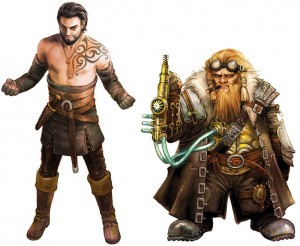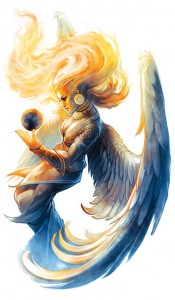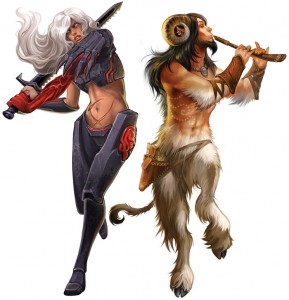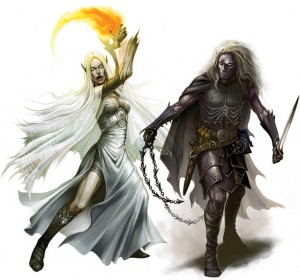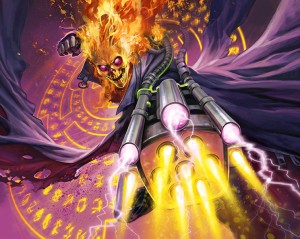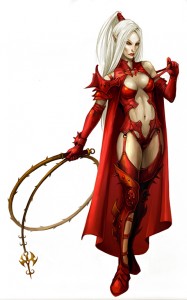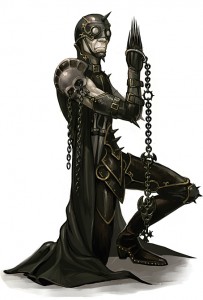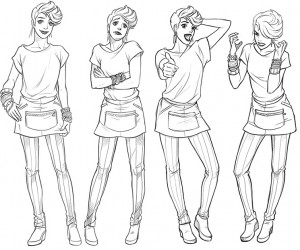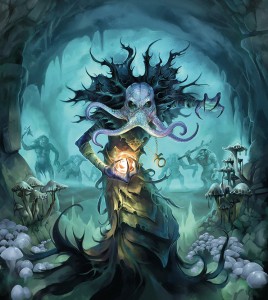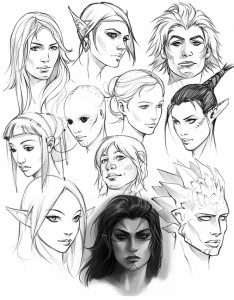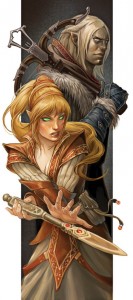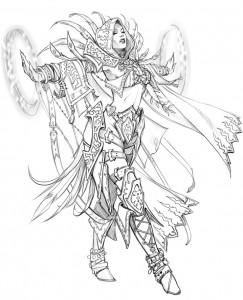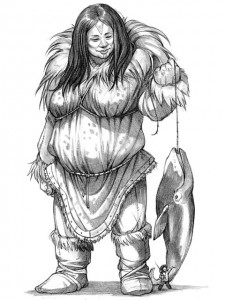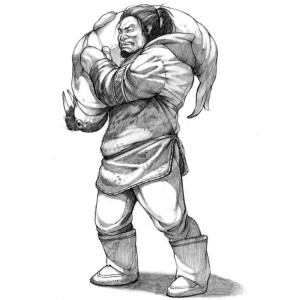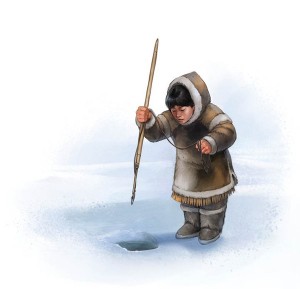Eva Widermann is one of those illustrators who manage to create an entire world of fascinating stories and powerful characters – the kind that seem to be living outside the paper, by what appears to be efortless hand drawing.
Born in Germany, Eva lives now in Cork, Ireland, where she works as a freelance illustrator. You’ll find her artwork in historical, educational books and magazines, and if you are a RPG (role-playing game) fan, you have probably seen it, already. Some of her collaborations include Wizards of the Coast (Dungeons & Dragons game), Paizo (Pathfinder game) and Disney (City Girl), and the many other projects she left her mark on vary from game apps to children’s books and private commissions.
What I probably enjoy most about Eva Widermann’s art is the fact that it makes everything seem possible. You don’t even have to be playing the game to feel that way, it’s enough looking at one of her illustrations and you’re completely drawn into a complex world where the ladies are beautiful warriors and the evil creatures look fiercely realistic. A world that surprises you every step of the way, because, even though you might think you’re familiar with character concepts (your childhood fairytale stories surely had a fairy, a leprechaun, a mermaid or a beast of some kind, along the way), still the way they are created is completely new and, for most people, unexpected. I wish my imagination was that good, when I was a kid. Or that my illustration books could have contained such detail.
And if you, too, are wondering how could someone imagine – and then express! such amazing concepts on paper, Eva was kind enough to be featured here, on Friday Illustrated, and answer all my curious questions, in the interview below 🙂

You are probably best known for your work in the game art industry, as an illustrator for characters in role-playing games. What were you doing before that?
I worked as a graphic designer in advertising agencies, mainly in the field of exhibitions and museums, logistics, cars and food & health business. Quite the difference from what I do now, I know 🙂
What was your first job in the gaming field? Was it something you had been wanting to do, or it just happened?
My first serious gig was a RPG called “Engel” published by Feder & Schwert, based in Mannheim, Germany. They were developing a second version of the game and were in need of an artist. I knew the Engel RPG already and was a huge fan of the illustrations of the first version of the book, done by Dieter Juedt. So for me it was an amazing chance and quite the honour to participate in the project!
Where did your passion for mythology and fantasy creatures come from?
That started very early, I’d say. I always loved fairytales, Brothers Grimm, Hans Christian Andersen, all the classics. I watched lots of the old eastern european fable movies on TV and I started to teach myself to draw in Disney style when I was 5 years old. The old movies really inspired me. I guess the biggest influences were “The Last Unicorn”, Ridley Scott’s “Legend” and Disney’s “Black Cauldron”. The Horned King was the first undead I became fascinated with
© Images Copyright: Wizards of the Coast, Paizo Publishing, Disney, Inhabit Media, Frogster.
Reading is so important for your imagination!
You have studied graphic design in Munich. How much did school influence your work, up until this day? Could you have gotten here by just being self-taught?
I often think back to the time when I studied graphic design and what I learned. I must say, it has given me the fundamental knowledge I needed to take the step as a freelancer. Once you are running your own business, you need to know all about marketing and branding. There was actually nothing better I could’ve done than studying design! It really helped me a lot to understand how to gain interest from clients, distributing my work, shaping my own brand etc. We had intensive drawing lessons at the academy, plenty of life drawing, calligraphy, colour theory, etc. Combined with the years of working in advertising, this knowledge has helped shaping the position I have now. I don’t say you couldn’t get there by self-teaching only. I know people who never studied graphic design and they successfully learned everything by themselves. But I think that self-teaching often results in learning things you like to learn and you work yourself into a comfort-zone you can’t break out of very easily. Whereas when you take a course, you are being confronted with your weaknesses and forced to learn everything that’s necessary, no matter if you enjoy it or not.
Your work requires a lot of creativity – you practically create full characters from nothing. Where does your inspiration come from?
I just keep my eyes open wherever I go. I can get inspiration from a boring walk to the groceries. I study people’s faces as they pass by. I study the colours of my environment. I am very interested in costume design all throughout history and my book shelves are bursting with reference books and museum catalogues! I started to teach myself sewing so I could understand the principles of dressmaking, the shapes, the materials, the decorations. I also did Reenactment for over 10 years and I learned a lot from wearing historical costumes, armor and weapons. Playing RPGs now and then also helps a lot to get ideas. And simply reading books. God, reading is so important for your imagination!
Do you do your drawing on paper first, or all digital? What kind of graphic tablet do you work on?
Most of my work is done digitally these days, I’m afraid 😉 It’s just so much more efficient for working with clients. Faster revisions, change of colour, etc. It adds a lot to the work flow. Though, I still enjoy scribbling in my sketch book but that’s only for private stuff and studies or when I’m drawing outdoors. I am using the Cintiq 24hd, before that I worked for years on the Intuos A4.
© Images Copyright: Wizards of the Coast, Paizo Publishing, Disney, Inhabit Media, Frogster.
I like authentic characters and I like creating characters that people can identify with
You have a wide range of character-types, in your portfolio – from human warriors, dwarves and leprechauns, fairies and mermaids, or evil creatures, to ‘girly’, sweet characters (like the ones in the Disney game). What is your favorite type of character, the one you most enjoy working on?
I like non-stereotypes a lot, actually. The “normal” people are the most interesting in my opinion. Non-perfection is a challenge I enjoy very much. Besides that, I really like a cartoony style, too.
How do you do your research, when starting a new fantasy character (research regarding costumes, weaponry and such)?
As mentioned earlier, I have a huge archive – in my book shelves, on my computer and in my head. I can spend hours just flipping quickly through it and taking bits and pieces, toying around and creating something new. When you’re designing something, you have to take care that you don’t get tangled in too many possibilities (that happens very quickly). Always step back and try to see it through the eyes of someone who doesn’t know the character and has to figure out what it’s all about. It needs consistency in style and a background story to become believable, to get an identity. It’s almost like graphic design again 😉
When researching for this interview, I found a fascinating observation about the way you draw your female fantasy characters, in this article. It basically states that your female characters are naturals, managing to kick ass without owning huge swords, exaggerated costumes or harsh facial expressions. On the contrary, they look authentic and practical. Is this something you specifically plan, when working on a character, or does it come naturally?
I think it’s both. As I said, I like authentic characters and I like creating characters that people can identify with. Especially since we’re living in a world in which we are confronted with perfectionism on a daily basis and a lot of what we see in ads, games and everyday life is defined by stereotypes. But why are the best stories often the ones where we fall in love with the anti-hero? It’s the same with character design. There are too many Galadriels, Lara Crofts, Gandalfs, etc… they are great and have reasons why they are such successful figures but they also repeat and get a bit boring. I guess the TV series “Game of Thrones” is a great example of what I want to explain. They took the word Fantasy to a new level by taking away a lot of the clichees. The armor and costumes are functional and well thought through, the actors look “cool” enough but could also be the person sitting next to you on the bus or train, you know what I mean? That’s authentic. Still, as an illustrator, you have to knock off the stereotypes as well, of course 😉 And they are fun too!
© Images Copyright: Wizards of the Coast, Paizo Publishing, Disney, Inhabit Media, Frogster.
How much of a gamer are you, when you are not drawing? Do you have a favorite game?
I love games but I only play a few since my spare time needs to consist of something different for a change. I’m a fan of the Diablo lore, Zelda and the rest of the Nintendo universe I grew up with. At the moment I enjoy playing Blizzard’s Hearthstone since it’s very easy, fun and less time consuming. Once a month we also have a Pen & Paper game at our house and I really enjoy the social factor. Nothing can beat a good RPG evening with friends.
You also teach character design workshops. If you had to resume the lessons in a workshop to just a few lines, what would those be? What are the most important notions you teach people who want to learn to design characters?
The workshops differ from the level of experience of my students, of course. Besides some fundamentals like how to get ideas during the design process, the main message I always try to deliver is that you don’t have to re-invent the wheel when designing a character. Everything has been there already at some stage, at some time and it is tough to come up with something completely new. Instead, dig in the vast ocean of cultural differences this world is offering. Combine, change, turn around and suddenly you will have something new. Look at Steampunk for example. It’s nothing else than a combination of something that has already been there. But by mixing different worlds you get something interesting and new. In my workshops I always show students my work process from start to finish, how I look up reference material and how I create an inspiration board, working with shapes and expression and body language to finally create a believable character.
© Images Copyright: Wizards of the Coast, Paizo Publishing, Disney, Inhabit Media, Frogster.
The culture of the Inuit is so fascinating and the rest of the world doesn’t know much about it
You worked in the Arctic, for a while, on one of your projects. Sounds like a once-in-a-lifetime, amazing experience – and not many people get to do something like that. How was that, for you?
That was just so unique to what I ever experienced before, hard to find proper words for it. Simply getting the chance to live somewhere so remote and alien for a month is absolutely mind blowing. I learned so much in that short time and it helped me a lot with creating art for the Inuit Mythology Project. The culture of the Inuit is so fascinating and the rest of the world doesn’t know much about it.
Seems like your passion for mythology has found the perfect place to live – in the land of fantasy stories of its own. All jokes aside, is there any connection at all between your work and choosing to live in Ireland?
It is funny that I somehow managed to end up living in Pixieland, I know 😉 I went to Ireland the first time when I was 19 years old and fell in love with the country immediately. But I never actually considered moving there, I had no reason and my life in Germany wasn’t too bad either. But Destiny decided to send this certain Irishman to cross my paths and six months later we were engaged! Flying between Germany and Ireland became a bit expensive and so I decided to pack my stuff and move to Cork and start a new life. Best decision ever!
Talking about future projects, do you have any type of project you dream of doing, but haven’t done yet?
There are too many! I think I would love to do more art for myself sometime again. I have an idea for an exhibition. I also think I want to focus more on mentoring and teaching in the future. But to be honest, I am not thinking about the future much, I rather juggle with the opportunities life throws at me and figure out in which direction it leads me. It has never failed me so far!
See more of Eva Widermann’s amazing work on: website | facebook | behance | deviantART


